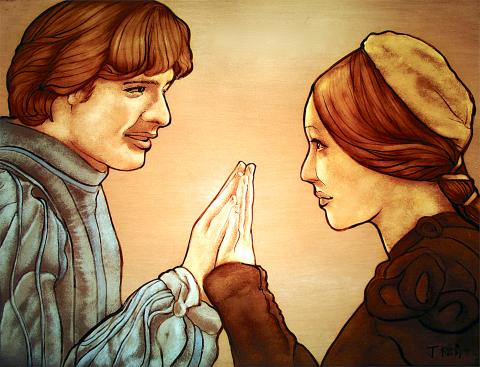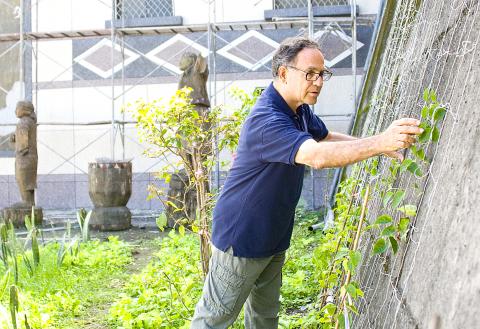Father Barry Martinson says there is an element of suffering to making art. He liked painting and writing when he was a child, but ever since he arrived in Chingchuan Village (清泉), an Aboriginal community nestled in the picturesque mountains of eastern Hsinchu, it has become more of a “mission” to beautify his surroundings, whether it be murals depicting Aboriginal life in his church or mosaics on the walls of a basketball court.
And now, he is on a mission to renovate the community’s main street.
“Some people just love to paint and paint. I don’t. I’ve got to have a motivation,” he says.

Photo courtesy of Barry Martinson
Martinson says in the 40 years he’s lived in Chingchuan, it has gone from attractive brick houses to drab concrete blocks and tin shacks. Neither he nor the villagers have the money to beautify the street, so Martinson is putting on an exhibition of his stained-glass paintings at Taipei 101 starting tomorrow.
Martinson says he has wanted to clean up the streets for a long time, especially since the village has become a tourist destination due to its hot springs and the former residences of writer San Mao (三毛) and former Chinese Nationalist Party (KMT) marshal Chang Hsueh-liang (張學良), who served part of his house arrest here for kidnapping KMT leader Chiang Kai-shek (蔣介石) in 1936.
“This is all people see of our village,” Martinson says. “As far as they’re concerned, Chingchuan is just a bunch of shacks. I think: ‘what a shame.’”

Photo: Han Cheung, Taipei Times
Neither the villagers, mostly laborers and farmers, nor Martinson had the funds to do anything, so he started making and selling stained-glass paintings. The remaining pieces — mostly consisting of movie scenes — will be displayed at Taipei 101 starting tomorrow, along with a choral performance by village children.
Martinson has three helpers for his work, which is done in the traditional way with multiple shadings and firings. The vivid, figurative pieces with detailed shading and thick black outlines can be lit up with a built-in LED light.
The original theme for this collection was “Faces of Love,” which not only includes Biblical images but also movie scenes and famous figures, including Audrey Hepburn and the Buddha.

Photo: Han Cheung, Taipei Times
“The idea was so the beautiful face of the village would come from the beautiful faces of the stained glass,” Martinson says.
YOU ARE YOUR HOUSE
Martinson is happy now when he leaves his church to visit with villagers, mostly Atayal Aborigines.
Three years ago, his paintings funded the youth community center, sprucing up an abandoned building in the process. For the past month, scaffolding has aligned the street as workers have installed geometric Atayal patterns to the facades of the concrete houses.
A large tribal mosaic is planned for the tallest, four-story building whose bleak gray side faces incoming traffic. An empty landing has been turned into a garden, with plants set to climb up an otherwise drab retaining wall.
“People were pleased that there was a tribal flavor without being too conspicuous,” Martinson says. “I wanted it to look like it’s been there all the time.”
Martinson says most of the project has been completed with local labor.
“The idea is to help people realize that this is a renovation not only of your exterior but your interior,” he says. “That their street is beautiful should help them feel pride about themselves. I always say, you are your house.”
Martinson’s plans for the village don’t end here. His next goal is to create a loop through the village for tourists to stroll around instead of going straight to the attractions. Then villagers can make some extra income by setting up stands outside their homes.
Jesuit priests can request to be transferred, and Martinson has thought of leaving many times, but each time, he’s decided against it.
“It’s my faith,” he says. “I don’t wear it on my sleeve, but we believe that when our superior sends us somewhere, it’s where God wants us to be. Then it’s the people ... and third, the nature.”
EXHIBITION NOTES
What: Love in the Movies Stained Glass Paintings
When: Tomorrow to Dec. 11
Where: Gallery 101 (in Taipei 101), 7, Sec 5, Xinyi Rd, Taipei City (台北市信義路5段7號)
Details: Auction on Dec. 11
On the Net: www.facebook.com/丁松青神父愛的容顏-1449027295406227/

Most heroes are remembered for the battles they fought. Taiwan’s Black Bat Squadron is remembered for flying into Chinese airspace 838 times between 1953 and 1967, and for the 148 men whose sacrifice bought the intelligence that kept Taiwan secure. Two-thirds of the squadron died carrying out missions most people wouldn’t learn about for another 40 years. The squadron lost 15 aircraft and 148 crew members over those 14 years, making it the deadliest unit in Taiwan’s military history by casualty rate. They flew at night, often at low altitudes, straight into some of the most heavily defended airspace in Asia.

Beijing’s ironic, abusive tantrums aimed at Japan since Japanese Prime Minister Sanae Takaichi publicly stated that a Taiwan contingency would be an existential crisis for Japan, have revealed for all the world to see that the People’s Republic of China (PRC) lusts after Okinawa. We all owe Takaichi a debt of thanks for getting the PRC to make that public. The PRC and its netizens, taking their cue from the Chinese Communist Party (CCP), are presenting Okinawa by mirroring the claims about Taiwan. Official PRC propaganda organs began to wax lyrical about Okinawa’s “unsettled status” beginning last month. A Global

Taiwan’s democracy is at risk. Be very alarmed. This is not a drill. The current constitutional crisis progressed slowly, then suddenly. Political tensions, partisan hostility and emotions are all running high right when cool heads and calm negotiation are most needed. Oxford defines brinkmanship as: “The art or practice of pursuing a dangerous policy to the limits of safety before stopping, especially in politics.” It says the term comes from a quote from a 1956 Cold War interview with then-American Secretary of State John Foster Dulles, when he said: ‘The ability to get to the verge without getting into the war is

Like much in the world today, theater has experienced major disruptions over the six years since COVID-19. The pandemic, the war in Ukraine and social media have created a new normal of geopolitical and information uncertainty, and the performing arts are not immune to these effects. “Ten years ago people wanted to come to the theater to engage with important issues, but now the Internet allows them to engage with those issues powerfully and immediately,” said Faith Tan, programming director of the Esplanade in Singapore, speaking last week in Japan. “One reaction to unpredictability has been a renewed emphasis on